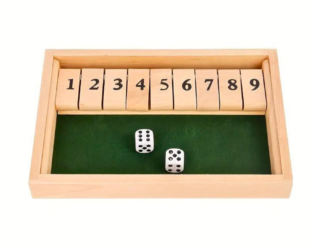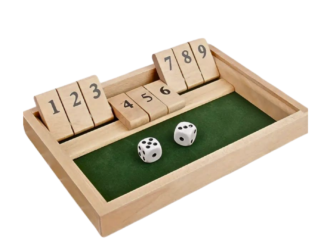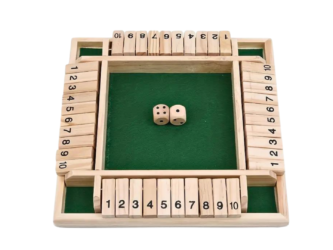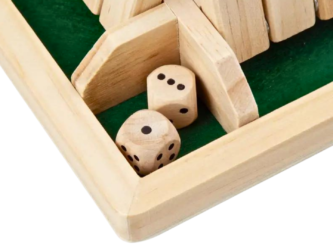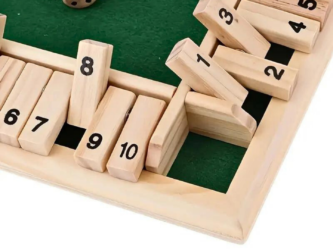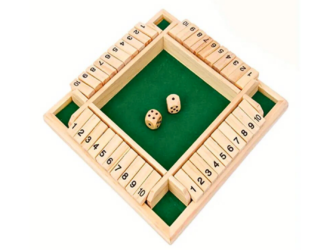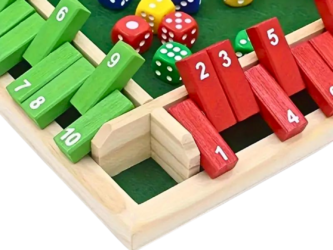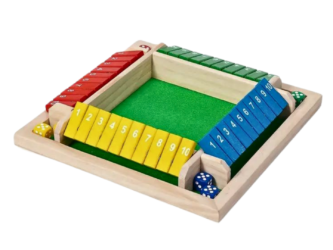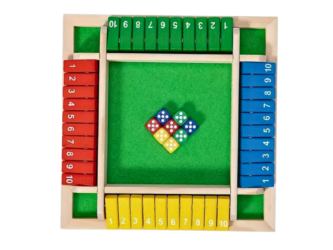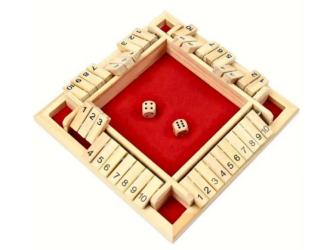Shut the Box
Shut the Box
Shut the Box is a traditional dice game that has stood the test of time, offering players a blend of strategy, chance, and entertainment. Its origins date back to 12th-century Europe, and it remains popular across the globe, enjoyed by players of all ages. The game is simple to learn but challenging enough to keep even seasoned players engaged. In this article, we’ll explore everything you need to know about Shut the Box, including its history, rules, strategies, and why it continues to captivate players today.
What is Shut the Box?
Shut the Box is typically played with a rectangular wooden box featuring numbered tiles, usually ranging from 1 to 9 or 1 to 12. The objective is simple: using dice, players roll to “shut” or flip down as many numbered tiles as possible, ultimately aiming to close the box entirely. The player with the fewest points remaining on their open tiles at the end of the game is the winner.
The beauty of Shut the Box lies in its simplicity, making it accessible to children, families, and casual gamers alike, while also providing enough depth to keep competitive players engaged.
The History of Shut the Box
Shut the Box originated in Northern Europe, with records suggesting that sailors in Normandy, France, were some of its earliest players. From there, it spread to England and became a pub game staple. Historically, it was also a popular gambling game, where players would place bets before each round.
Over the centuries, Shut the Box has evolved but maintained its core gameplay. Today, the game can be found in homes, classrooms, pubs, and even mobile apps, proving its lasting appeal.
How to Play Shut the Box: Basic Rules
Shut the Box is a versatile game that can be played alone or with multiple players. The rules are straightforward, and learning the game takes only a few minutes.
- Setup: The game begins with all numbered tiles (1-9 or 1-12) standing up or “open.” Each player takes turns rolling two dice to start their turn.
- Rolling the Dice: After rolling, the player must flip down one or more numbered tiles that add up to the total of the dice rolled. For example, if a player rolls a 9, they can either flip down the tile numbered 9, or any combination of tiles that add up to 9, such as 3 and 6 or 4 and 5.
- Closing the Box: The goal is to flip down as many numbers as possible during your turn. If a player cannot flip any more tiles based on their dice roll, their turn ends, and their score is calculated by adding up the numbers that are still open.
- Winning the Game: The game can be won in one of two ways: by completely flipping down all the tiles (“shutting the box”) or by having the lowest remaining score when all players have had their turn.
Variations of Shut the Box
Shut the Box is known for its flexibility, and several variations exist to suit different preferences. Some of the most common variations include:
- Single Dice Play: In this variation, players use only one die instead of two, making it easier to flip the tiles.
- Higher Number Variations: Some Shut the Box games have numbers that go up to 12 or even higher, increasing the challenge.
- Team Play: For larger groups, players can form teams and take turns trying to “shut the box” together.
- Gambling Variant: Historically, Shut the Box was a gambling game where players would wager money on their ability to close the box.
Strategies for Shut the Box
While Shut the Box is a game of chance, involving dice rolls, there is an element of strategy that can help players improve their odds of winning. Here are a few tips to keep in mind:
- Target High Numbers Early: In the beginning, aim to flip down the higher numbers, as these will be harder to close later on in the game when you are left with fewer options.
- Manage Risk: Don’t always take the obvious choice. Sometimes it’s better to leave tiles that give you more flexibility for future rolls, especially if they include common sums like 6, 7, or 8.
- Single Die Strategy: If you reduce the total number of tiles to a sum of six or lower, you can switch to rolling just one die. This increases your odds of getting the numbers you need to shut the box.
- Practice Makes Perfect: Like many strategy-based games, playing often can help you refine your approach and make better decisions based on the dice outcomes.
The Modern Appeal of Shut the Box
Shut the Box has moved beyond pubs and into homes and classrooms due to its educational value and ease of play. Parents and teachers often use the game to teach children basic math skills, particularly addition and probability. The tactile nature of the game makes it engaging, while its quick pace keeps it exciting for all ages.
Moreover, Shut the Box is perfect for social gatherings. It’s easy to set up, doesn’t take long to play, and can accommodate a range of players—from kids to adults—making it a versatile choice for parties, family nights, or pub game tournaments.
Why You Should Play Shut the Box
- Fun for All Ages: Shut the Box is a family-friendly game that can be enjoyed by players of all ages. Its simple rules and fast gameplay make it a hit for casual gatherings.
- Improves Math Skills: The game helps players develop quick mental arithmetic skills, as they must add up the dice roll and find the best combination of tiles to flip down.
- Portable and Easy to Learn: Shut the Box is a highly portable game that’s easy to learn and requires no complex setup. You can take it with you on trips, to the park, or play it at home.
- Encourages Social Interaction: Shut the Box encourages friendly competition, making it a great icebreaker or activity to bring people together.
- Endless Replayability: With each game taking only a few minutes and the random element of the dice rolls, no two games of Shut the Box are the same. This ensures long-lasting enjoyment.
Conclusion
Shut the Box is a classic game that has stood the test of time for good reason. It’s simple to learn, fast-paced, and offers endless fun for both casual players and those looking for a bit of strategic challenge. Whether you’re playing at home with family, teaching kids math skills, or engaging in a friendly competition with friends, Shut the Box is a versatile game that will keep you coming back for more.
If you haven’t yet tried Shut the Box, now is the perfect time to discover why this ancient game has remained popular for centuries. It’s easy to play, fun for all ages, and guarantees hours of enjoyment!

